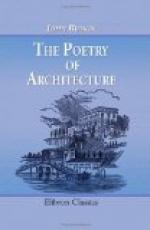[Footnote 40: There must always be a difficulty in building in picturesque blue country in England; for the English character is opposed to that of the country: it is neither graceful, nor mysterious, nor voluptuous; therefore, what we cede to the country, we take from the nationality, and vice versa.]
So much then for our British blue country, to which it was necessary to devote some time, as occupying a considerable portion of the island, and being peculiarly well adapted for villa residences.
C. The Woody or Green Country.
204. The woody, or green country, which is next in order, was spoken of before, and was shown to be especially our own. The Elizabethan was pointed out as the style peculiarly belonging to it; and farther criticism of that style was deferred until we came to the consideration of domestic buildings provided with the means of defense. We have therefore at present only to offer a few remarks on the principles to be observed in the erection of Elizabethan villas at the present day.
205. First. The building must be either quite chaste, or excessively rich in decoration. Every inch of ornament short of a certain quantity will render the whole effect poor and ridiculous; while the pure perpendicular lines of this architecture will always look well if left entirely alone. The architect therefore, when limited as to expense, should content himself with making his oriels project boldly, channeling their mullions richly, and, in general, rendering his vertical lines delicate and beautiful in their workmanship; but, if his estimate be unlimited, he should lay on his ornament richly, taking care never to confuse the eye.
Those parts to which, of necessity, observation is especially directed, must be finished so as to bear a close scrutiny, that the eye may rest on them with satisfaction: but their finish must not be of a character which would have attracted the eye by itself, without being placed in a conspicuous situation; for, if it were, the united attraction of form and detail would confine the contemplation altogether to the parts so distinguished, and render it impossible for the mind to receive any impression of general effect.
Consequently, the parts that project, and are to bear a strong light, must be chiseled with infinite delicacy; so that the ornament, though it would have remained unobserved had the eye not been guided to it, when observed, may be of distinguished beauty and power; but those parts which are to be flat and in shade should be marked with great sharpness and boldness, that the impression may be equalized.
When, for instance, we have to do with oriels, to which attention is immediately attracted by their projection, we may run wreaths of the finest flower-work up the mullions, charge the terminations with shields, and quarter them richly; but we must join the window to the wall, where its shadow falls, by means of more deep and decided decoration.




